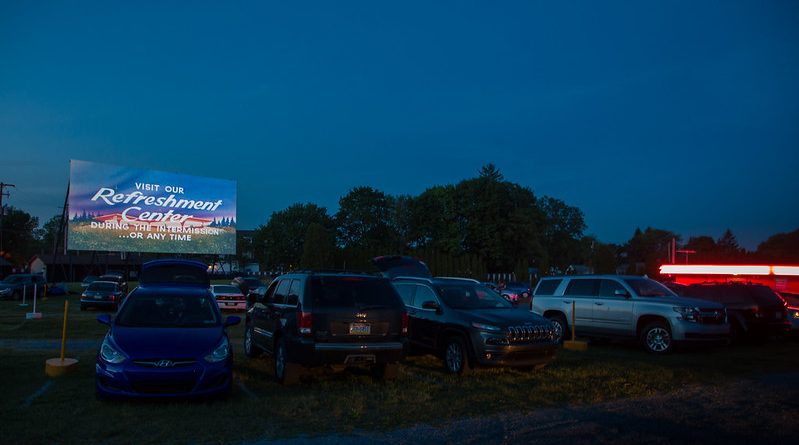Blast from the Past: The Drive In Theatre
A drive-in theater or drive-in cinema is a form of cinema structure consisting of a large outdoor movie screen, a projection booth, a concession stand, and a large parking area for automobiles.
The screen can be as simple as a painted white wall, or it can be a steel truss structure with a complex finish. Originally, the movie’s sound was provided by speakers on the screen and later by individual speakers hung from the window of each car, which was attached to a small pole by a wire.
Early drive-ins
A partial drive-in theater—Theatre de Guadalupe—was opened in Las Cruces, New Mexico in 1915:
In 1921, a drive-in was opened by Claude V. Caver in Comanche, Texas. Caver obtained a permit from the city to project films downtown. With cars parked bumper-to-bumper, patrons witnessed the screening of silent films from their vehicles.
In the 1920s, “outdoor movies” became a popular summer entertainment, but relatively few “drive-in” experiments were made due to logistical difficulties.
The drive-in theater was patented in New Jersey by chemical company magnate Richard M. Hollingshead, Jr..
Hollingshead’s drive-in opened in the state in 1933, It offered 400 slots and a 40 by 50 ft screen.
Failing to make a profit, Hollingshead sold the theater after three years to a Union, New Jersey, theater owner who moved the infrastructure to that city. Then the concept caught on nationwide.
The April , 1934, opening of Shankweiler’sAuto Park in Orefield, Pennsylvania, was followed by Galveston’s Drive-In Short Reel Theater in July and then the Pico Drive-In Theater at Pico and Westwood boulevards in Los Angeles in September . The Weymouth Drive-In Theatre in Weymouth, Massachusetts opened in 1936 snd In 1937, three more opened in Ohio, Massachusetts and Rhode Island, with another 12 during 1938 and 1939 in California, Florida, Maine, Maryland, Massachusetts, Michigan, New York, Texas and Virginia.
The Drive In boom
After 1945, rising car ownership and suburban and rural population led to a boom in drive-in theaters, with hundreds being opened each year
By 1951, the number of drive-in movie theaters in the United States had increased from its 1947 total of 155 to 4,151.
The drive-in’s peak popularity came in the late 1950s and early 1960s, particularly in rural areas, with over 4,000 drive-ins spread across the United States in 1958. They were a cheaper alternative to in-door cinema theaters because not only did they save the gas of driving out to the city and then back home, but the cost of building and maintaining a drive-in theater was cheaper than that of an indoor theater, resulting in the lower overall cost of attendance.
Among its advantages was the fact that older adults with children could take care of their infant while watching a movie. At the same time, youth found drive-ins ideal for a first date. Unlike indoor cinema theaters, there was an air of informality that was appealing to people of all ages, but specifically to families. The drive-in’s success was rooted in its reputation of being a family-friendly place. Parents were able to bring their children to the theater, often in pajamas, without worrying about bothering other movie-goers and were also able to spend time together without paying the expenses of babysitters. Drive-ins catered to their known audience, offering luxuries such as bottle warmers and diaper vending machines, and later miniature golf courses, swimming pools, and even motels on the land with windows facing the screens so that viewers could watch the films from their beds.
During the 1950s, the greater privacy afforded to patrons gave drive-ins a reputation as immoral, and they were labeled “passion pits” in the media. The 1978 movie Grease portrays the local drive-in as a preferred spot for trysts. This indicates that the drive-in theater experience was a part of North American pop culture during this time, coupled with people’s love for cars and movies. It was also popular among young people to meet up and have sex, smoke marijuana and drink alcohol. It was appealing to young people as it allowed them to express freedom and liberty they would otherwise lack at home.
One of the largest drive-in theaters was the Johnny All-Weather Drive-In in Copiague, New York. Covering over 29 acres, it could park 2,500 vehicles.
Decline
Several factors contributed to the decline of the drive-in movie industry. Beginning in the late 1960s, drive-in attendance began to decline as the result of improvements and changes to home entertainment, from color television and cable TV to VCRs and video rental in the early 1980s. Additionally, the 1970s energy crisis led to the widespread adoption of daylight saving time (which caused drive-in movies to start an hour later) and lower use of automobiles, making it increasingly difficult for drive-ins to remain profitable.
Mainly following the advent of cable television and video cassette recorder (VCR), then with the arrival of DVD and streaming systems, families were able to enjoy movies in the comfort of their homes. The new entertainment technology increased the options and the movie watching experience.
The runaway inflation and real estate interest rate hikes in the late 1970s and early 1980s made the large land tracts used by drive-ins increasingly expensive and thus far too valuable for continued use as drive-ins. By the late 1980s, the total number of drive-ins still operating in the US and Canada fell to less than two hundred.
Beginning in the late 1970s and extending through the mid-1990s, those drive-ins still operating acquired a quasi-novelty status, catering to the wave of “boomer nostalgia” and loyal patrons. This “retro” appeal eventually led to a revival of sorts by the end of the 1990s.
In the second half of the 2000s, drive-ins had another decline because of the oil crisis and a worsening economy. Reduced use of automobiles and more people moving out of suburban and rural areas during the 2010s have also put the drive-in’s future at risk, with numbers again on the decline.
By 2013, drive-ins comprised only 1.5% of total movie screens in the United States, with 389 theaters in operation nationwide, mostly located in the South and the West Coast (at the industry’s height, about 25% of the nation’s movie screens were at drive-ins).A figure of 348 operating drive-ins was published for the United States in March 2014.
The ongoing conversion of film distribution from celluloid to digital also puts additional pressure on drive-in theaters. Most small drive-ins lack the finances needed to convert to digital projection.




